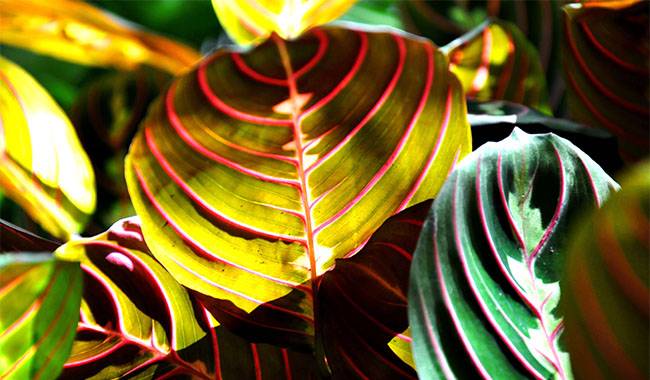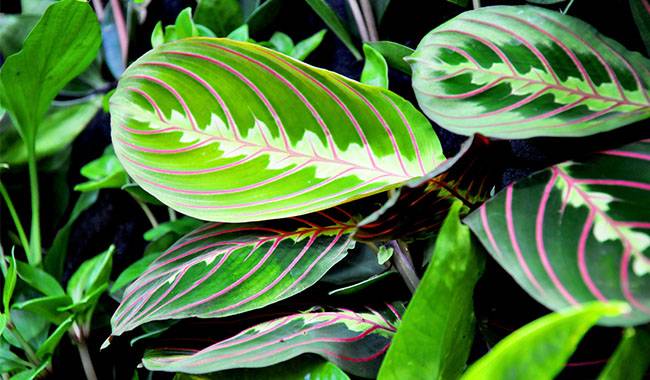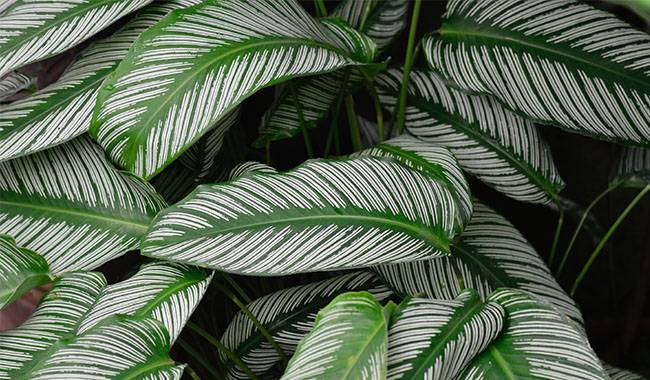
The feathery pattern on Maranta’s large, velvety leaves is the plant’s main, but not only, advantage. Because it requires exceptional moisture and meticulous care, Maranta is attractive for its detail. The lush, large leaves that unfurl from the tubes, the amazing response to environmental changes, and the unique texture make this plant special. The most common obstacle to growing Maranta is its requirement for high humidity. But if you can handle regular spraying and give it the attention it needs, it will quickly become a favorite. They respond very positively to care. You will learn how to grow Maranta plants in ThumbGarden’s article.
MARANTA PLANT DESCRIPTION
Maranta is often confused with iris, and sometimes even with pectinatus and stonecrop, to the point where they almost lose their identity. However, it is one of the most distinctive tropical ornamental foliage plants.
Maranta is often referred to as a prayer plant. It is truly one of the most sensitive plants, always in motion and responsive to humidity and light. Maranta can be viewed with interest throughout the day. It is named for its amazing talent: at night, on cloudy days, or in uncomfortable conditions, its usually horizontal or slightly sloping leaves, which look like they are in a flowering pattern, stand upright.
They are perennial herbs with thickened tuberous rhizomes and nodding stems, known for their large oval-ovate leaves. They hardly ever bloom indoors.
The perfectly elongated ovals of Maranta’s large leaves unfold from their “tubes” – the turned sheaths – and the process of opening the lamellae seems fascinating in itself what to say about the patterns that adorn the upper side of the leaves.
Feathery, interesting, symmetrical, with a play of veins and spots that fold into contrasting patterns, the leaves seem perfect. And the leaves’ unique corduroy texture only accentuates their beauty. The soft blue-purple color at the bottom seems to have been created by nature to set off this beauty.
TYPES OF INDOOR MARANTA PLANTS
Maranta range from fairly compact plants to huge plants – not just in leaf size. The height varies from 8 inches (20 cm) to 40 inches (1 meter) more.
Some of the most popular types are listed below.
Maranta leuconeura is a large-leaved species with contrasting lettuce spots and strings along the central vein. It has fine white lines on the square-shaped emerald dark green leaves.
Its individual forms and hybrids with special coloration are also popular.
Maranta Massangeana has dark olive, almost brown leaves decorated with light green spots. Massangeana with blue stripes and spots on an olive and emerald background.
Maranta cristata (syn: Maranta bicolor) is a non-mossy herb with wavy ovate leaves up to 6 inches (15 cm) long, with whitish stripes spreading over a soft, medium-green surface set off by a black spot.
Maranta arundinacea is a large bushy species with tuberous roots and shoots up to 40 inches (1 m) tall, hidden beneath light green long ovate leaves up to 10 inches (25 cm) long.
GROWING CONDITIONS FOR INDOOR MARANTA PLANTS

A planter, flower room, or greenhouse display is ideal for Maranta. But humidity and warmth can also be found in bathrooms and living rooms – provided they are properly cared for.
This plant does not tolerate direct sunlight and feels better in a soft, semi-shady environment. There is no need to put it on a windowsill (if so, it should be placed on a northern windowsill). An area with diffused shade not too far from the window is fine. In strong shade and bright light, the pattern will disappear. Maranta cannot be lighted: if the plant is cultivated under artificial light, constant light should be maintained for 16 hours a day.
Maranta prefers extremely stable conditions. Throughout the year, they need a constant temperature in the range of 64-77 °F (18-25°C). During active growth, it is best not to allow temperatures to drop below 68 °F (20°C). In winter, Maranta can tolerate short term air temperature drops to 59 °F (15 °C) and substrate temperatures to 64 °F (18 °C). This plant is susceptible to air currents.
HOME CARE FOR MARANTA PLANTS

Maranta has difficulty maintaining a comfortable humidity level, making it not a plant for everyone. Without experience in meeting all its vagaries, creating a comfortable environment without a flower display is very difficult.
Watering and Air Humidity
Maranta is one of those plants that require a drastic change in watering strategy during the winter. During active vegetation, water the plant so that the soil is always moderately moist, drying only the top layer and draining excess water from the trays immediately afterward. In winter, watering is reduced by allowing the substrate to dry almost completely. Watering is reduced starting in September. maranta needs soft water and slightly warmer water – equal to or slightly above room temperature.
All Maranta, without exception, require very high air humidity. Even at average levels, the leaves will begin to lose their “luster” – they will still have dry leaf tips, the rate of development and “behavior” of the plant will change, and the patterns will fade. A combination of heat and humidity is provided for Maranta by spraying and installing a humidifier. Only warm water should be used for spraying. An occasional hot bath is acceptable.
Feeding and fertilizer composition
Fertilizer should be applied year-round for this plant, but only in the winter to maintain ornamental foliage. Fertilizer is applied every 15-20 days from March to October and every 45-50 days in winter. If the vegetation does not stop and there is new leaf growth even in the winter, you can feed Maranta as often as before, halve the fertilizer concentration.
Special fertilizers for ornamental foliage plants or special mixtures for Maranta will be more suitable. Mineral and organic fertilizers can be used interchangeably. Producers should halve the dosage.
Pruning and transplanting Maranta
Young plants look like they form a nice leafy clump, but shoots will gradually elongate, and plants will become more and more scattered. When individual shoots become too large, or plants become oversized, pinch or shorten as needed. Pruning also prevents the bush from spreading out as it ages. Dull, wilted, damaged leaves are best removed regularly. As the bush grows, repot as needed. Transplant the plant by placing a very high drainage device 2 inches (5 cm) above the bottom of the container.
Maranta can be grown both as a potted plant and as an ampelopsis. The bushes keep spreading out, the shoots and leaves droop, forming evocative mats, and many varieties look even better in hanging baskets. The main thing is to make sure the diameter of the container is greater than the depth, corresponding to the size of the plant, and that it has drainage holes.
The best choice of substrate is a soil mix for arrowroot plants. A general-purpose, slightly acidic substrate with additional loosening agents (pine needles, charcoal soil, coarse sand, perlite) will also work.
Pests and problems in cultivation
Maranta often attracts aphids, spider mites, and thrips. If the leaves cannot be washed off, insecticide treatment must be started immediately.
The plant’s foliage signals discomfort. In most cases, if there is incorrect light, dry air, or watering problems, the leaf tips will wilt, and spots will appear on the Maranta. However, sometimes shoots can become soft, indicating too much fertilizer or wet soil.
Propagation and regeneration of Maranta
This plant can be divided into several bushes when repotting or taking cuttings. Maranta cuttings root easily in both uncovered substrate and water. Be very careful when dividing so as not to damage the roots.







